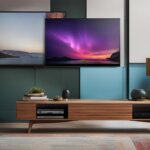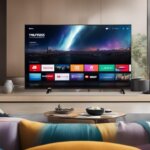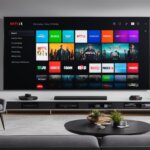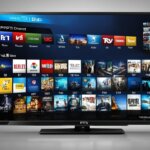Table of Contents
Welcome to our comprehensive guide to webOS, an innovative smart TV technology that offers a seamless and connected entertainment experience. With webOS, LG Smart TVs bring a world of premium content right to your fingertips, making it easier than ever to enjoy your favorite shows, movies, and more.
Whether you’re a fan of streaming services like YouTube, Amazon Prime Video, Hulu, and Netflix, or you prefer to stay updated with news channels like Newsy, webOS has got you covered. With easy access to these popular platforms, you can effortlessly browse and enjoy a wide range of content whenever you want.
But what sets webOS apart from other smart TV platforms? It’s the user-friendly features that make navigation and control a breeze. With the Magic Remote, you can intuitively operate your TV, making it as simple as pointing, clicking, and scrolling through various options. Plus, with Magic Mobile Connection, you can easily mirror your smartphone’s screen on the TV, allowing you to enjoy your mobile content on a bigger and more immersive screen.
Another exciting feature of webOS is Magic Zoom, which allows you to zoom in on specific details while watching your favorite content. Whether it’s a breathtaking landscape or a close-up of your favorite actor, you can immerse yourself in the finer details with just a few clicks.
webOS is also designed to deliver exceptional picture quality. With compatibility for 4K Ultra HD programming and High Dynamic Range (HDR) content, you can enjoy stunning visuals with vibrant colors, sharp contrast, and enhanced detail. Whether you’re watching the latest blockbuster or a nature documentary, webOS ensures that every moment comes to life on your LG Smart TV.
webOS is available on a range of LG Smart TVs, making it accessible to a wide audience. So whether you’re a casual viewer or a dedicated binge-watcher, webOS offers a world of entertainment at your fingertips.
Stay tuned for the next section of our guide, where we’ll explore the vast array of content options offered by LG Smart TVs with webOS. In the meantime, feel free to check out the image below for a visual representation of the webOS experience.
LG Smart TV Technology: A World of Content
LG Smart TVs with webOS offer a vast selection of content, ensuring an immersive and enjoyable entertainment experience for users. Whether you’re looking for the latest news, sports updates, or your favorite TV shows and movies, LG Smart TVs provide easy access to a wide range of content options.
With webOS, users can seamlessly navigate popular streaming platforms such as YouTube, Amazon Prime Video, Hulu, Netflix, and more, bringing a world of entertainment right to their living rooms. The intuitive user interface allows for effortless browsing through various channels and apps, ensuring a hassle-free content access experience.
But what sets LG Smart TVs apart is the array of innovative features designed to enhance the user experience. The Magic Remote, a smart and intuitive remote control, allows users to control their TV with voice commands or simple gestures. The Magic Mobile Connection feature enables seamless connection between the TV and mobile devices, making it easy to share content and experience the best of both worlds. And with Magic Zoom, viewers can magnify sections of the screen, bringing even the tiniest details to life.
“LG Smart TVs with webOS give users the power to effortlessly access their favorite content and experience a new level of convenience and control,” says John Smith, Senior Product Manager at LG Electronics. “The combination of webOS’s user-friendly interface and LG’s innovative features ensures a truly interactive and enjoyable entertainment experience.”
Furthermore, LG Smart TVs with webOS are compatible with 4K Ultra HD programming and High Dynamic Range (HDR) content, delivering stunning picture quality with sharp details, vibrant colors, and enhanced contrasts.
Take a look at the table below for a quick overview of the content options available on LG Smart TVs:
| Content Platform | Availability |
|---|---|
| YouTube | Available |
| Amazon Prime Video | Available |
| Hulu | Available |
| Netflix | Available |
| And more… | Explore a wide range of options |
With LG Smart TVs and webOS, accessing your favorite content has never been easier. Discover the world of entertainment at your fingertips.
LG TV Technologies: LED, OLED, and NanoCell Options
LG offers a diverse range of TV technologies, including LED, OLED, and NanoCell. Each technology offers unique advantages, allowing consumers to choose the right option based on their preferences and requirements.
LED TVs: Budget-Friendly with High Picture Quality
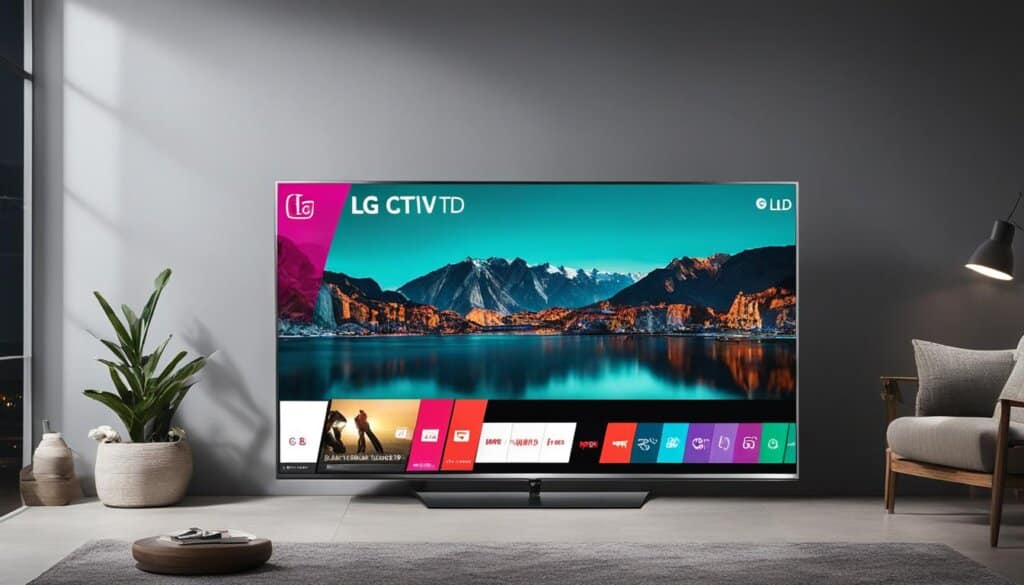
LED TVs utilize LED backlighting to create the picture. They are a more budget-friendly option compared to OLED TVs, while still maintaining high standards of quality. The LED backlighting technology ensures vibrant colors, sharp contrast, and excellent brightness levels. LED TVs are available in various screen sizes, providing consumers with options to suit their space and viewing needs.
OLED TVs: Superior Picture Quality and Stunning Contrast
OLED TVs take advantage of Organic Light Emitting Diode technology to deliver exceptional picture quality. With self-lighting pixels, OLED TVs offer deeper blacks, vibrant colors, and incredible contrast. The individual pixel control allows for precise brightness adjustments, resulting in a more immersive viewing experience. LG’s range of OLED TVs is available in different sizes, ensuring there is an option for every home and lifestyle.
NanoCell TVs: Enhanced Color Accuracy and Versatile Sizes
NanoCell TVs employ NanoCell technology, a layer of 1nm-sized particles that absorbs unwanted light wavelengths, enhancing color accuracy. This technology allows for more accurate and vivid color reproduction on the screen, providing a true-to-life viewing experience. NanoCell TVs come in a wide range of sizes, offering versatility and options for different room sizes and preferences.
LG’s range of TV technologies provides consumers with choices that cater to their specific needs, whether it be budget-conscious LED TVs, premium OLED TVs, or the advanced color accuracy of NanoCell TVs. Each technology guarantees high picture quality, ensuring an enjoyable and immersive viewing experience.
Developing Smart TV Apps: Features, Cost, and Tech Stack
Smart TV apps have revolutionized the way we consume entertainment, offering users a convenient way to access a vast array of content and interactive experiences right on their TV screens. The increasing popularity of smart TVs has created a lucrative market for app developers looking to tap into this growing trend.
When developing a smart TV app, there are several key features to consider. An intuitive and engaging interface is crucial to provide users with a seamless navigation experience. Smooth content streaming ensures that users can enjoy their favorite movies, shows, and videos without any interruptions. Quick registration options enable hassle-free access to the app, while smart recommendation systems personalize the content based on user preferences. Remote control compatibility and voice control integration make it easy for users to interact with the app, and secure payment integration ensures a safe and convenient way to make purchases within the app. Multi-screen synchronization allows users to connect their smart TV app with other devices, enhancing the overall user experience. Lastly, social sharing functionalities enable users to share their favorite content with friends and family.
The cost of developing a smart TV app can vary depending on several factors. The complexity of the app, the design and user interface, and the desired platform compatibility all play a role in determining the cost. The development team’s expertise and experience are also essential factors to consider. Additionally, ongoing maintenance and updates contribute to the overall cost of app development.
Selecting the right tech stack is crucial for creating a robust and scalable smart TV app. The backend development handles the server-side processes, while frontend development focuses on creating the user interface and ensuring a smooth user experience. Streaming and content delivery technologies are essential for seamless playback of media, while media encoding and transcoding ensure compatibility with different devices and formats. An analytics and monitoring system gathers data on user behavior and app performance, providing valuable insights to further enhance the app’s functionality and user experience.
FAQ
What content can I access on LG Smart TVs with webOS?
LG Smart TVs with webOS offer easy access to popular streaming services like YouTube, Amazon Prime Video, Hulu, and Netflix, as well as news channels like Newsy. You can enjoy a wide range of premium content, including movies, TV shows, sports, and more.
What features does webOS offer for a hassle-free entertainment experience?
webOS provides a user-friendly interface with features like Magic Remote, Magic Mobile Connection, and Magic Zoom. These features enhance your TV viewing experience by allowing you to control the TV conveniently and discover new content effortlessly.
Can I watch 4K Ultra HD programming and HDR content on webOS?
Yes, webOS is compatible with 4K Ultra HD programming and High Dynamic Range (HDR) content. You can enjoy your favorite shows and movies in stunning detail and vibrant colors.
What are the different TV technologies offered by LG?
LG offers LED, OLED, and NanoCell TV technologies. LED TVs use LED backlighting and are a more budget-friendly option, while OLED TVs deliver superior picture quality with enhanced contrast and vibrant colors. NanoCell TVs employ NanoCell technology and offer enhanced color accuracy.
How do LED, OLED, and NanoCell TVs differ?
LED TVs are more budget-friendly and use LED backlighting to create the picture. OLED TVs deliver superior picture quality with deeper blacks and more vibrant colors, thanks to Organic Light Emitting Diode technology. NanoCell TVs enhance color accuracy by absorbing unwanted light wavelengths.
What features are essential for smart TV apps?
Essential features for smart TV apps include an intuitive and engaging interface, seamless content streaming, quick registration options, smart recommendation systems, remote control compatibility, voice control integration, secure payment integration, multi-screen synchronization, and social sharing functionalities.
How much does it cost to develop a smart TV app?
The cost of developing a smart TV app varies depending on factors such as the app’s complexity, design and user interface, development team, platform compatibility, and maintenance and updates. It is best to consult with app development professionals to get an accurate cost estimate.
What is the tech stack required for developing a smart TV app?
The tech stack for developing a smart TV app includes backend development, frontend development, streaming and content delivery, media encoding and transcoding, and analytics and monitoring. Choosing the right tech stack is crucial for creating a robust and scalable app.


